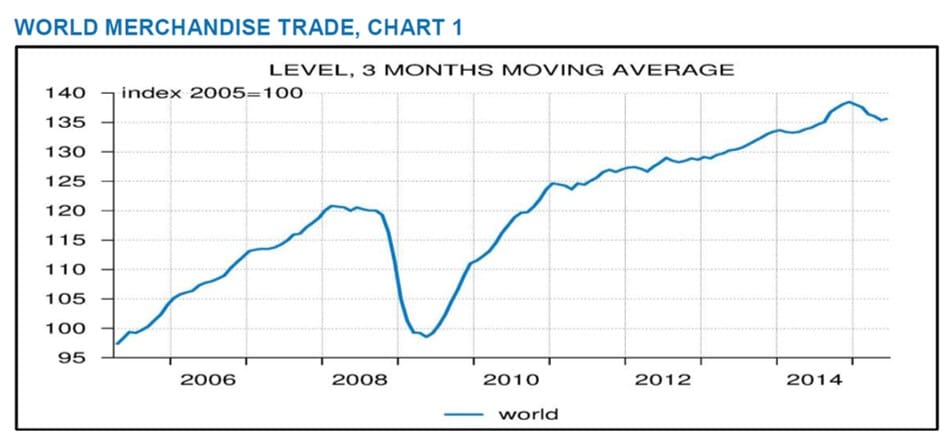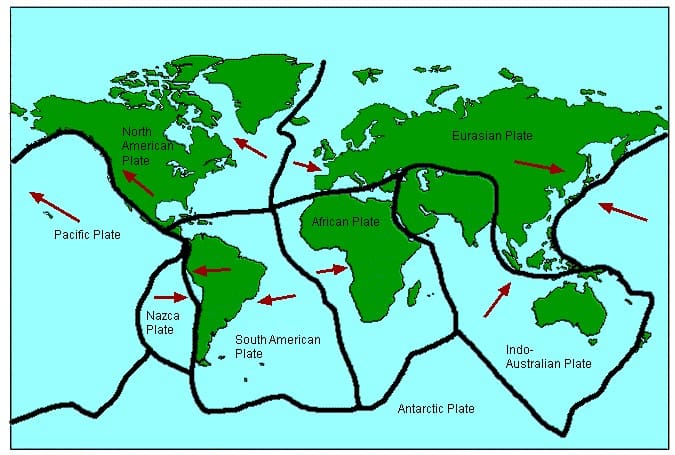
China and global financial markets were the top news stories this week. But the financial volatility still appears to me as detached from the global economy and international trade. Or is it? Is this just financial “noise” or is it an indication of changes in the global trade? I believe it’s still too early to know for sure. The closest indication of a downturn in international economic activity is the World Trade Monitor’s recent estimate of stagnant global trade. However, to what degree is this driven solely by basic commodities? And is the slump in basic commodities prices driven by increased supply, decreased demand, or simply the strengthening dollar (a recently unstable measuring stick)? These are all interesting questions for which I have no certain answer.
Now onto this week’s logistics news:
- World trade suffers biggest fall in 6 years (FT, registration may be required)
- Interest in nearshoring remains strong, but trend may be slowing
- Three Little Words Could Transform E-Commerce
- Mapping the future of U.S. transportation infrastructure
- Target Logistics Receives Contract to Build a New Workforce Lodge in West Texas
World trade volume declined by 0.5 percent in the second quarter of 2015, according to the World Trade Monitor (Netherlands Bureau for Economic Policy Analysis). The first quarter also declined by 1.5 percent. Although these percentages represent negligible declines, they are significant because until recently, global trade has been growing at twice the pace of the global economy. The slowdown in trade raises questions about the causes and the specific regions, commodities, finished goods, and trade routes. This data came out just after the increased concern of China’s economy, as the country’s equity markets plunged, the currency was devalued, and interest rates were lowered. The FT article quotes Robert Koopman, the chief economist of the World Trade Organization about the drivers behind the trade slowdown. He noted a halting recovery in Europe and a slowing economy in China as major factors. But he also noted a structural shift in the global economy, with China transitioning to greater domestic consumption and a trend of manufacturers looking to shorten their global supply chains and bring production closer to consumption, known as a “nearshoring” movement. Although there are numerous examples of companies relocating production from emerging markets like China back to the US. I have not yet located comprehensive data that evaluates the degree to which this is occurring. Although the reasons typically given for nearshoring initiatives typically boil down to quicker time to market and/or a trade off between supply chain and labor costs.

The Nearshoring trend remains strong, but some executives are concerned about the stability and security in some of these nearshoring locations, according to a recent study by AlixPartners, The study notes rising labor costs in China as hindering that region’s cost advantages, while the depreciation of the Mexican peso is improving Mexico’s relative attractiveness. Notably, for companies outside of North America, Eastern European countries remain the most attractive option. Meanwhile, many firms are considering North Africa and the Middle East as well. The mention of currency valuations and China’s rising labor costs adds context to the recent devaluation of the Chinese yuan, as it appears the devaluation will somewhat slow the eroding cost advantages from rising labor costs in China.
![]() Three words. What3Words? Exactly. Have you ever heard of this company? I hadn’t until this week. This UK-based start-up company has divided the world into a grid of 57 trillion 3×3 meter plots of land. Rather than using GPS coordinates, they have attached a unique three word combination to every plot. One potential application for this naming convention is areas of the world without formal addresses, such as many rural parts of emerging markets. These three word names will be easier for individuals to remember, will automatically be associated with GPS coordinates, and can serve as a communication intermediary for processes such as e-commerce deliveries. So basically, the system provides its own unique address system that is associated with a GPS coordinate. I have a decent understanding of GIS overlays from my research on that market. For example, electric power distribution associates power line GPS coordinates with address and roads. OK, someone can more easily remember or identify a set of words than a set of GPS coordinates. But here is my question about What3Words – How are those three words going to help a courier get to your location? Addresses are, after all, are typically associated with a transportation mechanism…streets, etc.
Three words. What3Words? Exactly. Have you ever heard of this company? I hadn’t until this week. This UK-based start-up company has divided the world into a grid of 57 trillion 3×3 meter plots of land. Rather than using GPS coordinates, they have attached a unique three word combination to every plot. One potential application for this naming convention is areas of the world without formal addresses, such as many rural parts of emerging markets. These three word names will be easier for individuals to remember, will automatically be associated with GPS coordinates, and can serve as a communication intermediary for processes such as e-commerce deliveries. So basically, the system provides its own unique address system that is associated with a GPS coordinate. I have a decent understanding of GIS overlays from my research on that market. For example, electric power distribution associates power line GPS coordinates with address and roads. OK, someone can more easily remember or identify a set of words than a set of GPS coordinates. But here is my question about What3Words – How are those three words going to help a courier get to your location? Addresses are, after all, are typically associated with a transportation mechanism…streets, etc.
The Commercial Vehicle Outlook Conference is being held this week in Dallas. The conference included a panel discussion on the future of US transportation infrastructure. They discussed issues such as the politically contentious issue of highway funding, the longer-term decline of vehicle miles traveled (VMT) in the US, the increase in miles traveled since the recent decline of fuel prices, and the increase in highway fatalities associated with increased VMT. Also, interestingly enough, there is a decrease in driver licensing with younger generations. I find this interesting since one of my colleagues recently noted that his nephew didn’t care much about driving because he could more easily just call Uber. Uber truly is a market disruptive innovation.
New logistics investment in the fracking industry? Among all of the talk about oil and gas exploration downturns, layoffs, and project curtailments, it appears that fracking logistics is still in demand. Target Logistics just announced that it has been awarded a contract by one of the world’s largest independent oil and natural gas exploration and production companies to build and manage an accommodation facility at a fracking exploration site in West Texas. It looks like some fracking operations are still financially feasible at depressed fossil fuel price points.
Have a great weekend! This week’s video is of Hitachi’s warehouse picking robot.
https://www.youtube.com/watch?feature=player_embedded&v=1trfIYflmpw

















Leave a Reply